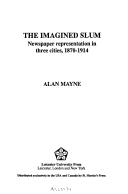A comparative analysis of the sensational depiction of slums in the yellow press of Britain, the United States and Australia between 1870 and 1914, and an examination of the thrust of urban renewal programmes during this period. Three case studies are highlighted: Birmingham in 1875; Sydney after the smallpox epidemic of 1881; and San Francisco after the outbreak of plague in 1900. The book argues that there is a clear genre of slumland representation in English-speaking popular newspapers of the period. Its contrived images of "the slum" have been misinterpreted by historians in their analysis of urban social conditions and of urban social reform. The author argues that uninformed reflection on and analysis of contemporary newspaper representations of slumland can be misleading in normal historical research. He asserts that slumland stories were a means of constructing and reinforcing popular "common-sense" views of the slum amidst the indeterminancies of modern big-city living. The landscape of the slum and the behaviour of its inhabitants were stereotypes which were used by newspapers to help clarify and consolidate the axioms of bourgeois city culture.
This text is an attempt to connect firmly modern cultural history to a well-established important section of mainstream social history research.
- ISBN10 0718513894
- ISBN13 9780718513894
- Publish Date 1 April 1993
- Publish Status Out of Print
- Out of Print 17 May 1999
- Publish Country GB
- Publisher Bloomsbury Publishing PLC
- Imprint Continuum International Publishing Group Ltd.
- Format Hardcover
- Pages 256
- Language English
